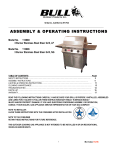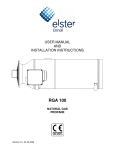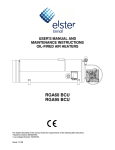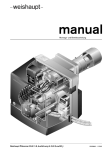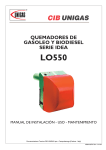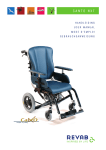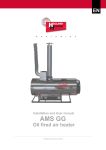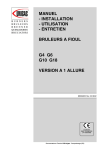Download P 40 - P 120
Transcript
USER'S MANUAL AND MAINTENANCE INSTRUCTIONS OIL-FIRED AIR HEATERS P 40 - P 120 BCU Issue 11.14 Congratulations on your purchase! We're sure you'll be very happy with your new Heater P 40 - P 120 BCU NOTE In order to ensure that your new equipment will always work properly and efficiently and to ensure your personal safety, we would ask you the following: Please read through this User Manual thoroughly and take particular note of the warning and safety instructions before starting up the machine for the first time. Issue 11.14 Contents Table of contents 1. General information ...................................................................................2 1.1. Symbols .................................................................................2 1.2. Special safety instructions ..................................................2 1.3. General safety regulations ...................................................2 1.4. Electrical equipment.............................................................3 1.5. Maintenance ..........................................................................3 1.6. Ordering spare parts ............................................................3 1.7. Liability ..................................................................................4 1.8. Interruptions due to power failures ....................................4 1.9. First Aid .................................................................................4 1.10 Discharge / Dealer ................................................................4 2. Introduction ................................................................................................5 2.1. Equipment description .........................................................5 2.2. Special safety regulations ...................................................5 3. Technical data ............................................................................................6 4. Installation instructions.............................................................................7 4.1. Number required ...................................................................7 4.2. Installation instructions .......................................................7 4.3. Connecting the oil supply ....................................................9 4.3.1. Oil lines .................................................................................11 4.4. Electrical connections.........................................................12 5. Operation ...............................................................................................15 6. Commissioning and adjustment ..............................................................16 6.1. General .................................................................................16 6.2. Installation ............................................................................16 6.2.1. Room thermostat .................................................................16 7. Protecting the environment .....................................................................17 8. Maintenance .............................................................................................18 9. Dealing with faults ....................................................................................19 10. Fitting Instructions..................................................................................22 Pump pressure / Stabiliser ....................................................................22 Oil atomising nozzle / Photocell ............................................................23 Ignition system / Orifice .........................................................................24 11. Assembly Drawing / spare parts list .....................................................25 11.1. Mobile version......................................................................26 12. Accessories .............................................................................................27 13. Return of goods form .............................................................................28 13.1 Contact .................................................................................28 User manual P 40 - P 120 Issue: 11.14 Page 1 1 General Information Page 2 1. General Information 1.1. Symbols You will see the following symbols when you read through the User Manual: Warning of a general danger Warning of dangerous voltage Wear protective gloves 1.2. Special safety instructions CAUTION NOTE This indicates risks or unsafe processes which can easily cause slight injury or damage to property. This provides information on how to handle the equipment effectively, economically and in an environmentally sound manner. 1.3. General safety regulations This equipment may only be used for the purpose for which it is intended. Use of the equipment for any other purpose shall be regarded as improper use. The manufacturer will not be liable for any damage resulting from improper use; the user shall bear the sole risk thereof. Proper use of the equipment also entails observing the manufacturer's conditions of operation, maintenance and installation. Currently applicable accident prevention regulations and all other generally recognised rules of occupational medicine and safety must be observed. Check all safety and operational equipment to ensure that it is safe and fully operational: • before starting up • at reasonable intervals • after any modifications or maintenance work 1 General Information Page 3 1.4. Electrical equipment • • • • • • • • • • • • • • Any work extending beyond the scope of equipment maintenance must be performed by a specialist only. Always follow local- and national regulations. The heater must always be connected to the mains electrical supply via an earthed socket. Keep the socket within reach. Always disconnect the appliance from the mains before performing any work on it. Never remove the safety grill while the heater is active or could be activated. Before starting up the appliance, examine all electrical wiring for any visible defects. Change any damaged wiring before switching on the appliance. Never remove the plug from the socket while the heater is active. Always allow the heater to cool down. Never use the heater while any component is missing. Have any plug devices that are damaged or destroyed replaced by a qualified electrician. Do not pull the plug out of the socket by the flex. Covering electric motors can cause high temperatures to build up, which can destroy the electrical equipment and cause fires. 1.5. Maintenance Always disconnect the appliance from the mains before working on the electrical equipment! Repairs should only be carried out by persons who have the training, knowledge or practical experience to ensure that the repair is done properly. Maintenance, repair and cleaning work should only be carried out with the drive switched off and the motor idle. The same applies to the rectification of functional defects. Wear protective gloves if there is a danger of injuring your hands! The user must satisfy himself that the appliance or machine has been returned to its proper state after carrying out repair work. Technical equipment must not be re-started until all safety devices are in place. Spare parts must at least correspond to the technical requirements specified by the manufacturer of the equipment. This will be the case if, for example, original spares are used. 1.6. Ordering spare parts When ordering spare parts, always indicate the following: • Code no. and description of part or item number with description and manual number for uncoded parts; • Number of original invoice; • Electricity supply, e.g. 230V, 50 Hz. User manual P 40 - P 120 Issue: 11.14 1 General Information Page 4 1.7. Liability Any unlawful alterations to the machine or the software will rule out manufacturer liability for any resultant damage. 1.8. Interruptions We recommend installing warning systems to monitor your operating equipment. This will protect your animals and plants and consequently your economic existence. In the case of a power failure, the emergency power unit should automatically switch on. Power units with cardan transmission for attachment to tractors are also suitable for use as emergency power units. Please consult your property insurance company for More information. 1.9. First Aid Unless explicitly specified otherwise, there should always be a first aid box at the workplace in case of accidents. Any material removed from the first aid box must be replaced immediately. when you ask for help, always provide the following information: • where the accident happened; • what happened; • how many persons injured; • what the risk of injury is; • who is reporting the accident! 1.10. Discharge After the installation or repairs of the installation, the packaging and non-usable waste should be delivered to the appropriate places. The contents of this manual are liable to change without notice. If you discover any errors or inaccurate information, we would be grateful if you could inform us of these. All trademarks named or depicted in the text are trademarks of their respective holders and are recognised as protected. Copyright 2009 by Elster-Instromet B.V. 2 Introduction Page 5 2. Introduction 2.1. Equipment description This air heater is ideal for heating and/or CO2 enrichment in greenhouses and plastic tunnels. The heaters are also excellent for heating poultry sheds or pig sties, or for heating or frost protection in areas used for the storage and/or preservation of potatoes, tuberous crops and the like. Particularly in their initial stages of life, young animals need a lot of heat, no matter whether they are poultry or pigs. Optimum temperatures right from the start have a decisive impact on their development, health and general performance. The P 40 - P 120 creates the right conditions for your room. This heater is available for use with kerosene/paraffin oil or diesel. No chimney is needed. The heater is installed exactly where it will be most effective in generating heat. 100% of the heat it produces will benefit your animals or plants - so there is no heat loss. Another positive feature is that the "open combustion" system increases the relative humidity in the room. CAUTION Diesel-fired heaters are not suited for heating and/or CO2 enrichment in greenhouses or plastic tunnels where plants or crops are being grown. The P 40 - P 120 is controlled by thermostat or by computer; it also has a photocell control. If for some reason the appliance does not ignite or the flame is extinguished, the oil supply is immediately cut off. One solenoid valve unit ensures high levels of safety. No oil can escape unburnt. 2.2. Special safety regulations The P 40 - P 120 are heaters for use in mentioned rooms. Use of the equipment for any other purpose shall be regarded as improper use. The manufacturer will not be liable for any damage resulting from improper use; the user shall bear the sole risk thereof. With storing manure, gases are formed which are partly dissolved. These poisonous and explosive gases (e.g. sulphurhydrogen and methane) can be released during stirring and rinsing. With a source of ignition a big explosion may occur. To prevent a hazardous situation shut off the heaters completely before stirring or rinsing. Also observe the following points: • Close the doors when manure is stored outside. • Ventilate the room thoroughly. Notice: No account is taken with general hazard of fire in this manual. Consult your fire insurance company and/ or your local fire brigade for more information. User manual P 40 - P 120 Issue: 11.14 3 Technical Data Page 6 3. Technical Data Oil-Fired Warm Air Heaters P 40 P 60 P 80 P 100 P 120 34000 40 136500 51000 60 204700 69000 80 273000 86000 100 341200 103000 120 409450 4 6 8 10 12 Kg/h 3,1 4,7 6,2 7,8 9,4 Air output m3/h cfm. 4400 2596 6200 3658 7700 4543 7700 4543 7700 4543 Motor speed 50Hz rpm 1400 1400 1400 1400 1370 Motor speed 60Hz rpm Electric Tension 50-60Hz V 230 230 230 230 230 Electric current 230V-50Hz A 2,2 2,5 3,5 3,5 4,5 4,6 480 550 770 770 1035 1058 Model Output kcal/h kW BTU Fuel consumption l/h 1650 230V-60Hz A Power 230V-50Hz W 230V-60Hz W Sound pressure dBA 67 70 73 73 76 Weight Kg 48 51 55 55 65 Throw ventilator m 30 30 40 40 50 Length mm 1288 1288 1288 1288 1488 Height mm 455 515 570 570 570 Width mm 521 576 624 624 624 Distance centre brackets* mm 800 800 800 mm 800 800 *Option, when mounted The P 40 - P 120 consists of 1. Shell 2. Combustion chamber 3. Ventilator 4. BCU 4 main components: : used for air supply. : the oil/air mixture is burned in the chamber and ignited by spark ignition. : this conveys the hot air into the room, supplies the air needed for combustion and the air for cooling the combustion chamber and the flue gases. : the Burner Control Unit; the regulation and safety apparatus. Description of materials: Shell and burner chamber BCU : : High-grade 430 stainless steel PPE (Environment temperature BCU: -10ºC to +60ºC) The materials used are capable of withstanding the maximum loads. 4 Installation Instructions Page 7 4. Installation Instructions 4.1. Number required The number of heaters required depends on the size and nature of the room, the required temperature and the relevant climate zone. 4.2. Installation Instructions CAUTION The following points must be observed! Mounting The heater must be properly secured using the suspensions eyes or (if it is being fixed down) using the tunnel brackets on its bottom. Secure the heater using chain or steel cable at least 4 mm in diameter. The heater must be as close to the horizontal as possible, and certainly not inclined at an angle of more than fifteen degrees. The heater must not be connected to a duct system and no inflammable objects should be placed within three metres of its outlet. Oil connection The oil used as fuel must be purified. (see page 10) Check the fuel supply lines regularly for leaks and loose fittings. The oil tank must meet the relevant environmental standards and must be contained within a spillage sump. The capacity of the sump must be at least the same as the capacity of the tank. The sump must be protected from the rain. The bush in the spillage sump through which the primary fuel hose passes must be watertight and oiltight by hose clips. The main fuel pipe must be sturdy and made of stainless material. The diameter of this pipe must be at least 3/4" (20 mm). The oil tank and each of the oil boxes must be fitted with a manual oil valve. The fuel hose must be secured to the heater and to the oil tank with suitable hose clips. Oil hoses should not be left on the ground, lead them along a steel construction or wall without sharp bends. Electrical Make sure to use a well earthed socket. Never take off the power when the heater is still working, always let it cool down. Safety Never remove the grille or service hatch when the heater is or might start running. Never use the heater when parts are removed Keep a free space around the heater, see next page To avoid oxygen depletion, the room in which the appliances are installed must have enough ventilation - either by a mechanical extractor device or ventilation system that extracts at least 10 m 3 of air per hour for every 1 kW of installed output, - or it must have adequate natural ventilation; If the room has two openings, a ventilation factor of 1.0 (i.e. one change of room air per hour) can be achieved naturally providing these openings have a free opening area of at least 60 x B cm2 where B is the installed output in kW. The overall output of the installed appliances must not exceed 1 kW per 20 m3 of room volume if natural ventilation is used. Always replace defect or faulty parts with original ones or with the same specifications. User manual P 40 - P 120 Issue: 11.14 4 Installation Instructions Page 8 Keep free from obstacles Keep free from flammable objects 4 Installation Instructions 4.3. Connecting the oil supply User manual P 40 - P 120 Issue: 11.14 Page 9 4 Installation Instructions Page 10 Option 1: The tank is higher than the heater Use a vacuum valve (B) to prevent spilling a complete tank of fuel in case of a leak. Option 2: The tank is lower than the heater The pump draws the fuel directly from the main tank. Make sure the oil doesn’t flow back, use a non-return valve (D) at the Mind the height difference, see table in chapter 4.3.1. The return oil hose has to end at least half way in the tank Option 3: Use of an extra oil pump Mind the pump pressure, use a reduction regulator, the pressure on the filter may not exceed 0,5 bar. Eventually use aluminium or brass filter jars, oil conduits that can sustain higher pressure and clamp them well on the nipples! Option 4: Use of oil boxes (4a: link to boxes of the next heaters) The oil box serves as a small reservoir, the oil circulates between the de oil box and the heater. Make sure the boxes are at least 10cm lower in relation to the underside of the tank. Connect a manual valve on each box. Bleed the boxes regularly! Advantage: no need for return hose(s) to the main tank. (A) (C ) (E) : Always use a filter when the oil or the tank may be dirty : Oil hoses max. 3/8", bigger diameters could cause air bubbles. : Note a distance to feeding and drinking equipment and from plants in glasshouses concerning dehydration. Always use purified fuel. Observe the fuel quality: CAUTION! Maximum sulphur content: Maximum water content: Viscosity approx: 1000 mg/kg 200 mg/kg 2 mm2/s 4 Installation Instructions Page 11 4.3.1. Oil lines The following features of the oil supply system must be compatible with one another: The total length of fuel hose or pipe used (i.e. fuel hose run) The diameter of the fuel hose The height difference between the oil tank and the heater The type of fuel to be used The table below shows the permissible combinations. Make sure that the oil supply system complies with this table. The figures in the table have been worked out on the assumption that the heater is higher than the oil tank. FUEL: Kerosene (paraffin oil) or Diesel (domestic fuel oil) quality see page 10. H = difference in height between bottom of oil tank (or oil box) and oil pump on heater (in metres). Ø = internal diameter of fuel line (in millimetres). L = maximum allowable fuel line run (in metres). KEROSENE/PARAFFIN OIL DIESEL H ø6 L ø8 L ø10 L ø12 L H ø8 L ø10 L ø12 L ø15 L 0 0,5 1,0 1,5 2,0 2,5 3,0 3,5 4,0 35 31 27 23 19 15 11 7 3 100 98 86 73 61 48 36 23 11 100 100 100 100 100 100 87 56 26 100 100 100 100 100 100 100 100 54 0 0,5 1,0 1,5 2,0 2,5 3,0 3,5 4,0 12 10 9 7 6 5 3 2 1 36 32 28 23 19 15 10 6 2 89 78 68 57 47 36 25 15 4 100 100 100 100 96 75 53 31 9 CAUTION Always use oil-resistant hoses with the correct hose clips! User manual P 40 - P 120 Issue: 11.14 4 Installation Instructions Page 12 4.4. Electrical Connections Unscrew the lid from the BCU and pull it off straight with both hands. The connection of the thermostat, external signals etc. are described below: (Wiring max. 2,5 mm2.) 1(2), 3(4) Mains connection 230V 21,22 Contact for optional external error signal (Light/klaxon, max. 253 V / 2 A !) 23, 24 Contact for extra Ventilator (Switches simultaneously with Ventilator appliance; max. 253 V / 5 A !) 25 24VAC/DC ( - ) in 26 Signal “Ventilate” 24VAC/DC( + ) in 27 Signal “Heating” 24VAC/DC( + ) in 28 Signal “Ventilate” 230VAC (from 30) in 29 Signal “Heating” 230VAC (from 30) in WARNING 30 230VAC (for 28 and 29) out Do NOT connect other heaters on contacts 28 till 32 (Phase sensitive) 31, 32 Optional connection for external reset button (contact) Do NOT use different phases. 4 Installation Instructions Oil valve Ventilator Photocell Alarm signal Signal ventilate Signal burning External reset button User manual P 40 - P 120 Issue: 11.14 Page 13 4 Installation Instructions Starting delay When multiple appliances start at the same time, some appliances may not get enough tension (230V) or gas(pressure) The BCU (lid) has a potentiometer (tE) with which per appliance a start delay of 0-60 seconds can be set. Per appliance a delay of 5-10 seconds should suffice. The following settings are set by the producer and should NOT be altered. Changes might lead to damage! Cooling down period: A standard of 10 seconds cooling down period is set but a longer period can be set. The middle potentiometer can add 0 to 100 seconds. For this appliance it is set to 50 seconds extra. Minimal burning time Every time a appliance starts, there is a short incomplete combustion A minimal burning time can be set with the left potentiometer, with which also life expectancy of relays, engine and other parts can be lengthened. (Only necessary when room thermostat is set too sensitive) Range: 0-180 Seconds. For this appliance it is set to 60 seconds extra. Put the BCU lid straight back to its socket and tighten it with the screws. Page 14 5 Operation Page 15 5. Operation Connect to 230V mains and (if present) open the oil valve. Press the white button (ON/OFF) of the BCU until one of the other LED’s light up, the appliance is switched “on“ in the last chosen setting. By pushing the red button continuously, different settings can be chosen (the chosen setting will start after 3 seconds) Error OFF Appliance will not react to any signal AUTO + AUTO 1 Appliance waits for a signal from the thermostat for heating or ventilating 2 Appliance will start burning (manual setting) 3 The ventilator will start running (and only this) 4 Appliance will ventilate continuously and waits for a signal from the thermostat for heating. 5 When the heater is activated, the electric motor starts, operating the oil pump and the fan. The oil pump draws fuel from the oil box or tank (depending on the type of oil supply system in use), the fan creates an air current providing the oxygen needed for combustion. The ignition is activated at the same time as the motor. If you look into the combustion chamber from the front while the heater is activated, you should see the blue ignition spark appear towards the back. A current from a transformer creates the spark. After about thirteen seconds, a voltage of 230 V is applied across the oil pump's magnetic valve causing it to open. You should be able to hear the click of the valve opening. Once the valve has opened, fuel is pumped to the oil atomising nozzle, from which it emerges as a spray, which is immediately ignited by the ignition spark. About two seconds after the burner has lit, the ignition system is deactivated. This helps prolong the life of the transformer; continuous ignition is in any case unnecessary because the heater uses a highpressure system. During operation, the heater is monitored and regulated by an automatic control box, the BCU, connected to a photocell, which monitors the flame in the combustion chamber. If a fault is detected when the heater is activated or while it is in operation - if, for instance, the oil supply fails or there is insufficient oxygen - the heater will immediately lock out. When this happens, all the components mentioned above except for the electric motor are automatically deactivated and the heater ceases to function. The red lockout indicator light on the BCU also comes on. If the reset button is pressed, the heater will start up again. However, if the fault has not been corrected, the heater will simply lock out once more. For advice on what to do if your heater develops a fault, see chapter 9. When the heater is deactivated or locks out automatically, the flame goes out but the fan will continue to run for about a minute to cool down the heater. User manual P 40 - P 120 Issue: 11.14 6 Commissioning and adjustment Page 16 6. Commissioning and adjustment 6.1. General CAUTION The "ventilate" mode is particularly useful in the summer. However, you must make sure that there is enough oil in the tank, since the oil pump could seize if it is not being lubricated by the oil. 6.2. Installation Before using the heater, read the safety instructions and make sure that the heater, fuel lines, oil tank, electrical supply and room thermostat are connected as described. (See chapter 1.2, 1.3, 2.2 "Safety instructions" and Chapter 4). Check the oil in the oil tank and proceed as follows: (*=when using oil boxes) 1.* Open the oil valves of the oil tank and oil boxes. 2.* ` Open the air bleeding valve of the oil box closest to the oil tank. As soon as it is full, oil will pour out, close the valve directly. 3.* Repeat this with all the following boxes. 4. Connect the heater to the mains. 5. Put the heater in mode “ventilate”: The motor will start turning and the oil pump will begin drawing oil from the tank. Wait while oil is drawn through the oil filter on the pump and flows along the return line back to the tank. Once this stage is reached, the oil system is primed. 6. 7.* Set the BCU back into mode “automatic”: AUTO Open the air bleeding valves of the oil boxes again to remove air bubbles. As soon as oil pours out, close the valve again. Repeat steps 4 to 7 with all other heaters 8.* The heater is now ready for use. Room thermostat For the heater to be regulated automatically, the BCU has to be in mode “automatic”. Set the room thermostat to the required temperature. When the room temperature falls below the set level, the heater will start and will keep heating until the temperature reaches the set level. Depending on the type of room thermostat in use and where it’s positioned, the room temperature is able to vary within a band either side of the temperature to which the thermostat is set. The difference between the temperature at which the room thermostat cuts in and the temperature at which it cuts out is referred to as the thermostat's differential. The smaller the thermostat's differential, the more often the heater will come on and go off. We advise using a room thermostat with a differential of ± 2C. It will activate the heater when the room temperature drops 1C below the set NOTE temperature, and deactivate when the room temperature rises 1C above the set temperature. Using a thermostat of this kind will reduce the likelihood of faults and improve the performance of your heater. Disconnecting the heater To disconnect the heater, wait until it is inactive and the fan has stopped (let it cool-down properly), then remove the mains plug from the socket. 7. Protecting the environment Page 17 7. Protecting the environment Before leaving the factory, the heaters are tuned to keep the emission of harmful substances to a minimum. Nevertheless, the combustion system will not function optimally if, for instance there is a shortage of oxygen the wrong fuel is used there is a leak in the oil supply system water gets into the oil tank (this can also damage the oil pump) or dirt gets into the oil supply system. Poor combustion can be harmful not only to the environment, but also to your crops, or to the room or space in which the heater is being used. Therefore, have your heater checked regularly to see that the combustion system is in good working order. Also, follow the safety and installation instructions closely. Service the heater at least once a year. Your oil storage arrangements must meet the relevant environmental standards. In other words, the tank must be contained within a spillage sump, the capacity of which must be at least the same as the capacity of the tank. The sump must also be protected from the rain. Regularly check the heater and the fuel hoses for leaks. If you have reason to disconnect a heater (say, to move it or replace it), make sure to catch the oil that runs out of the fuel lines and filter and dispose of it in an environmentally responsible manner. User manual P 40 - P 120 Issue: 11.14 8. Maintenance Page 18 8. Maintenance CAUTION Cleaning the heater with water jet/high pressure is only allowed with the protection caps on the BCU and gas combination control CG and with a distance of at least 50 cm to the heater. Inadequate cleaning can result in serious damage. Regularly check the heater(s) and all fuel hoses for loose connections and leaks. If you are using oil boxes, the bleed valve on the oil boxes must be opened regularly to allow any air which may have collected in the fuel lines to escape. If you use the heater seasonally, check that it is in good working order well before you need to use it, so that you have time to deal with any unexpected problems. Always disconnect the mains: Before carrying out maintenance work, always isolate the heater from the mains electrical supply by removing the mains plug from the socket. Periodically wipe the outside of the heater with a soft cloth. A small amount of a non-aggressive cleaning liquid may be used, but the heater must be thoroughly dried afterwards. Remove dust and dirt from the inside of the heater with compressed air. To do this you will need to remove the safety grille from the back of the heater or the service cover on the side. If the heater is being used in a very dusty environment e.g. a broiler house, the combustion head, the photocell and the photocell housing should be cleaned after every crop. To do this, you will need to remove the combustion head from the burner chamber by loosening the two wing bolts (see diagram chapter 10). The combustion head can then be withdrawn and cleaned (with compressed air). Make sure to clean the four air inlets on the stabiliser. The photocell can be cleaned with a dry cloth. Compressed air should then be blown through the photocell housing. When replacing the photocell in its holder, remember that it has to be oriented so that the pipe on the photocell clicks into the matching recess on the holder. Clean the oil filter on the pump when dirty. Do not forget the rubber O-ring when reassembling the filter. (Tighten the filter jar well!) After carrying out maintenance work, make sure that all components you have removed from the heater are correctly replaced. If you think that the heater or its combustion system is not working properly, consult an approved engineer. Approved engineers have special equipment with which they can check the heater thoroughly. 9 Dealing with faults Page 19 9 Dealing with faults If the heater develops a fault, it will lock out completely and the red lockout indicator light on the BCU will come on. The heater can be started again by pressing the lockout-reset button on the BCU. However, if the fault is not corrected, the heater will simply lock out once more. • • NOTE If the heater should lock out repeatedly, do not press the lockout-reset button more than three times. If the heater keeps locking out, isolate it from the mains electrical supply by removing the mains plug from the socket and contact an approved engineer. Remember that heaters only lock out when there is something wrong. So if your heater locks out, it may be faulty, there may be a problem with the heating system as a whole or with the room or space in which the heater is being used. If a component (e.g. the oil atomising nozzle, pump or photocell) needs to be replaced, the new component must be of an identical type. Failure to use the correct component may compromise the heater's safety or performance. Fault Diagnosis Turn the heater on (press the lockout reset button), then make the following checks: 1. Is the electric motor running? 2. Is there a good ignition spark? 3. Does the oil valve open after about fifteen seconds? (Audible by click) 4. Does the burner light? 5. Does ignition spark disappear about two seconds after igniting the burner? If any of these reveal a problem, you are half way to finding out what is wrong. The big red LED on the BCU shows a malfunction. The internal malfunction contact (21,22) closes. The kind of malfunction is shown by the flashing red LED’s (No. 1-5). See next page. To reset the appliance the red button should be pushed for at least 1/2 a second. High-tension danger! Disconnect power before working on this heater! Only authorised people should Do not try to repair the BCU, guarantee will be void and a safe operation cannot be guaranteed! To (remotely) reset the heater in principle only by authorised personnel and under supervision of the heater. User manual P 40 - P 120 Issue: 11.14 a) flame too small Oxygen depletion b) photocell (tube) dirty c) cable photocell loose d) photocell defect Heater burning Oil valve opens a) pump pressure too high/low b) oil return line kinked c) air openings (4) dirty d) burner head dirty e) old, worn defect nozzle f) Oxygen depletion g) object in 60° spray angle Smells / forms soot a) cable oil valve loose b) coil valve defect c) oil valve defect Oil valve doesn’t open (no “click”, no oil spray at outlet) Heater doesn’t burn (no flame at all) a) ignites at the wrong spot b) ignition cable loose c) electrode torn/cracked d) Fuse F2 (3,15A) in BCU defect e) cable ign. transformer loose f) ign. transformer defect No/ irregular ignition a) Tension too low b) pump runs heavy c) Capacitor engine defect ventilator turns slowly a) (manual) oil valve closed b) oil filter dirty/clogged c) oil pressure too low d) insufficient ignition e) air in the oil lines f) Oxygen depletion g) nozzle dirty h) Water in the oil lines a) pump ceased pump coupling broken Good, stable ignition 10 sec. 230V to: Ignition transformer (audible visible) pump doesn’t turn (no oil flow/ fan turns lightly) ventilator turns pomp turns Burns only 5 seconds (LED 4) (no photocell current) a) thermal fuse activated >push reset button on engine b) fuse F1 (8A) defect c) engine cable loose d) engine capacitor defect e) ventilator blocked f) motor defect ventilator doesn’t turn Set to “ventilate” Error 2+5 “false light” darken burner chamber ventilator doesn’t turn 3 sec. Set to “manual burning” 9 Dealing with faults Page 20 Flow chart P-serie BCU 9 Dealing with faults Page 21 List of possible malfunctions LED Malfunction BCU did not recognise a flame during the safety time. There will be no automatic start attempt 4 Cause (▄) / Solution (►) ▄ No (adequate) ignition ►Check distance electrodes; check connection ignition cable; clean ignition electrode; check ignition ▄ Bad flame signal caused by wrong setting burner ►Adjust burner (pressure) properly ▄ Not enough light current caused by dirty or badly connected photocell (-pipe) ►clean photocell (-pipe); also check the cable ▄ Air is the oil supply -> Bleed oil pump/conduits ▄ Short circuit at ignition- or oil valve connection BCU ► Check wiring. Advise: When a short circuit is found at the oil valve exit, the BCU should be sent back to the manufacturer, or: 1. Replace fuse F2: 3,15 A (slow, H) and check security function 2. Close manual oil valve. 3. Start the appliance for a few times and check security function 4. When a malfunction is detected, send the BCU to the manufacturer. WARNING! When this security function is not checked, the oil valves may stay open and unburned oil might flow into the room – Danger of explosion! Max. temperature of overheat cut off device (STB) ▄ Ventilator does not cool down 5 exceeded. (manual reset needed) ▄ Dirt ► Clean Max. temperature of overheat guard device (STW) ► Set a longer cooling down period 4+5* exceeded. (automatic reset) ▄ Dirt ► Clean Premature flame signal (before a flame is ► Faulty flame signal. 2+5 possible) Incorrect function of overheat cut off/guard device ► check connections 1+5 ▄ Temperature sensor is below –20°C 3+4* Time between two starts is too short. (automatic reset after waiting time) Flame dropped during operation ▄ Bad flame signal caused by wrong setting burner (Heaters with 3 start attempts will make ► Adjust burner (pressure) properly 2+4 a new start when the heater has burnt for ▄ Bad flame signal caused by dirty or badly connected at least 2 seconds) photocell. ►Clean photocell (-pipe); also check cable Remote reset (connection 31/32) is switched ► Only push reset when appliance has a 1+4 longer than 10 seconds. (Permanent reset) malfunction Flame signal did not dissipate within 5 seconds ► close oil supply 1+3 after the oil valves closed -> Oil valves do not ► check correct functioning burner / oil valves close properly. 1+2 Internal tension error During a malfunction more than 5 times in 15 minutes the remote reset (connection 31/32) is 3+4+5 switched. (automatic reset after waiting time) Errors indicated with a * will reset automatically after the problem has dissolved, sometimes after a small pause. Pushing the reset-button in this case has no use. User manual P 40 - P 120 Issue: 11.14 10 Fitting Instructions Page 22 10. Fitting Instructions CAUTION This chapter is intended for approved fitters and not for users. Pump pressure The heater's pump pressure is set at the factory. However, it is good practice to check the pump pressure from time to time - when the heater is serviced, for instance. Pump pressure should always be checked if the heater develops a fault, or if the burner is not operating properly. Check the pump pressure using a good pressure gauge with a range of 0 to 16 bar or 0 to 25 bar. The location of the pump's pressure gauge port and pressure adjustment screw are shown in the diagram below. 1. 2. 3. 4. Oil pump Danfoss RSA 060 ................ N51400010 Adjustment screw pump pressure Oil valve Rapa ....................................... N51400237 Oil filter GA 70452 1/4" .......................... N51400128 Aluminium Filter jar ................................ N51400198 5. Return line 6mm .................................... N51400219 6. Supply line 6mm .................................... N51400218 7. Serto ¼”x6mm coupling 90° ................... N52800051 8. Serto ¼”x6 coupling ............................... N52800049 9. Serto ¼” in x 6mm coupling ................... N51400216 10. Hose connection ¼” x 6mm ................... N51400217 The correct pump pressures for the various models of heater are shown in the table below Type P 40 P 60 P 80 P 100 P 120 Kerosene Diesel 9 bar 10 bar 9 bar 9 bar 9 bar 8 bar 8 bar 8 bar 10 bar 9 bar Pressures of up to 1 bar above or below the correct pressure are acceptable. The pump pressure can therefore often best be set on the basis of observed combustion performance. If the heater is giving off an unpleasant smell and the burner flame is too small, try increasing the pressure. If the burner flame is reddish and flames are coming out of the heater, try reducing the pressure. However, these problems are not necessarily down to incorrect pump pressure alone; the nozzle may (also) require attention. To be sure the combustion is optimal, better to measure the O2 percentage of the combustion. Optimal O2 percentage measured in the combustion chamber: 4% <> 6% Air chamber The air chamber is the square housing welded on the burner chamber. The burner head is attached on to the air chamber. The air chamber has four air inlets that provide air (oxygen) that is needed for the combustion process. The inlets are factory-adjusted and need no further attention, although the openings should be cleaned in dusty environments. Do not adjust the openings, altering the air supply will likely lead to ignition- or burning problems. 1 4 2 3 10 Fitting Instructions Page 23 Oil atomising nozzle The oil atomising nozzle and the pump pressure together determine the output of the heater. After a few years, a worn nozzle may deliver too much or too little oil. This in turn could lead to combustion problems described under "Pump pressure". If too little fuel is being delivered, and the pump pressure is correct, check to see whether there are any blockages in the fuel system, dirt in the oil filter or in the nozzle filter. If no blockages are found, the nozzle should be replaced. If too much fuel is being delivered, and the pump pressure is correct, check to see whether there are any leaks in the heater. If no leaks are found, replace the nozzle. • Replace the oil atomising nozzle with a genuine nozzle of the same make and type. The heater is designed and adjusted to suit that particular make and model of nozzle. • After a new nozzle has been fitted, check the adjustment of the ignition electrodes and the orifice (see diagram under “Ignition System”). The correct nozzles for the various models of heater shown in the table below. Heater model Make of nozzle DANFOSS Discharge (US-gal/h) Flow ltr/h Nozzle model Code no. Kerosene Diesel P 40 1,10 1,10 4 60 S N52800079 P 60 1,35 1,35 6 60 S N51100001 P 80 2,00 2,00 8 60 S N51300001 2,50 - 10 60 S N51400002 - 2,25 10 60 S N51800001 2,75 2,75 12 60 S N51500001 P 100 P 120 Photocell The photocell is mounted in a holder attached to the back of the combustion chamber. The photocell's function is to check whether there is a flame in the combustion chamber when the heater is activated and while it is in operation. If no flame is detected during activation or when the heater is in operation, the heater will lock out. However, if the photocell is dirty or faulty, it may not detect a flame even when there is one, causing the heater to lock out. The amount of burning LED’s changes per appliance, pump pressure and environment (dust/oxygen), but at least 4 LED’s should burn stable. To make the Led’s signal visible press red button and then directly (almost simultaneously) the white buton for 1 second. There are 11 steps: ○ ● ○ ● ● ● ○ ● ● ● ● ● ○ Flashing ● Burning ○ ● ● ● ● ● ● ● ○ ● ● ● ● ● ● ● ● ● 0 4 8 12 16 20 24 28 32 36 40 [µA] The current should be max. 19μA when the heater is activated and min. 25μA. during normal operation. If the current is more than 19μA when the heater is activated, the photocell is probably being "confused" by light from an external source. If during normal operation the current is less than 25 μA, the photocell is probably weak or dirty, the flame is irregular because the combustion head is dirty or the nozzle is blocked. User manual P 40 - P 120 Issue: 11.14 10 Fitting Instructions Page 24 Ignition System The ignition system is a vital part of your oil-fired air heater. Its function is to light the oil coming out of the nozzle, and it must be capable of doing so under adverse conditions such as extreme cold. It is therefore very important that it is properly adjusted. If the ignition system is badly adjusted, the ignition spark may form in the wrong place or may not form at all. This will cause the heater to lock out. If you look in at the front when the heater is activated, you should be able to see the ignition system come into operation. Between the two ignition electrodes a well-defined spark should be visible. Under the influence of the air current, the spark should form in front of the nozzle. If you can see a strong spark and it is in the right place, the ignition system should function properly. If the ignition electrodes should ever need adjusting, adjust them very carefully, because if the electrodes porcelain sleeving breaks or cracks, they will have to be replaced. The diagram shows how the ignition system should be adjusted. Petrol and diesel 1 2 3 4 5 6 7 Aluminium combustion head ………………….. N51400004 Combustion head bolt holes Orifice ……………………………………………. N51401005 Ignition electrodes 65 x 14 …………………….. N51400008 Oil atomising nozzle ……………………………. See chapter 10 Nozzle block …………………………..........…… N51400161 Serto nipple 1/8” x 4 …………………....…………N52990162 Combustion head excl nozzle petrol/diesel …… N51400278 Center in the middle Orifice The orifice is attached to the nozzle block (see upper diagram) The orifice ensures that the fuel and air are thoroughly mixed and trained to form a spiral jet. If the heater is used in a particularly dusty area, the orifice can become very dirty. This in turn can lead to combustion problems. The orifice should therefore be cleaned with a wire brush so that its blades are free of dirt. After cleaning, check that the whole combustion head assembly is properly adjusted before replacing it. 11 Assembly Drawing/Spare parts list P 40 - P 120 Page 25 11. Assembly Drawing/Spare parts list P 40 - P 120 Pos. Name Code nr. 1 Combustion head complete ....................................................................... See chapter 10 10 Pump unit complete ................................................................................... See chapter 10 18 Pump linkage 10 mm ................................................................................. N51400018 20 Oil conduit ø4mm ...................................................................................... N51100002 21 Motor P 40/P60: Elnor BX 335 EMR 230 V/300W ..................................... N51700008 Motor P 80/P 120: Elnor BX 350 EMR 230 V/440W .................................. N51400021 22 Fan P 40: 16”, 30° ..................................................................................... N51700078 Fan P 60: 18", 26 ..................................................................................... N52600032 Fan P 80 - P 120: 20" 28 (60Hz: 22°: N51400260)................................. N51400022 23 Motor bracket N51500015 24 Engine capacitor 16µF .............................................................................. N52800034 28 Service hatch............................................................................................. N51400220 30 Tube for photocell horticulture ................................................................. N51400032 32 Tube for photocell stable ......................................................................... N51400186 33 Photocell stable version QRB1C extra sensitive .......................... N51400275 Photocell horticulture version QRB1B less sensitive ............................ N51400273 34 Cable to spark plugs P-series 35 cm……………………………………………. N51400272 Cable to spark plugs P-series 40 cm ......................................................... N51400271 35 Cable to oil valve ....................................................................................... N51400238 39 Outlet Aluminium P40 complete ................................................................ N51100015 Outlet Aluminium P 60 (18") complete ....................................................... N51200004 Outlet Aluminium P 80 - P 120 (20") complete .......................................... N51400041 42 Bracket mantle (2x) ................................................................................... N51400046 44 Safety grille P 40 (16") complete ............................................................... N51100051 Safety grille P 60 (18") complete ............................................................... N51200026 Safety grille P 80-P 120 (20") complete ..................................................... N51400213 45 Combustion chamber P 40 complete ......................................................... N51100049 Combustion chamber P 60 complete ......................................................... N51200023 Combustion chamber P 80/P100 complete agriculture N51400310 Combustion chamber P 80/P100 complete horticulture ............................. N51400402 Combustion chamber P 120 complete ....................................................... N51500003 48 BCU Oil lid N51400196 BCU Oil socket (incl.Ignition transformer) N51400197 Transformer Danfoss EBI N51400206 User manual P 40 - P 120 Issue: 11.14 11 Assembly Drawing/Spare parts list P 40 - P 120 Page 26 11.1. Option: Mobile version 2 3 36 37 38 39 40 41 Room thermostat TH215 Cable 3 x 1,5 x 3 mtr. Push handle Oil tank 160 lt Oil tank cap Wheel ø400mm massive End cap wheel ø25 ¼“ stop to empty tank N50260146 N51400089 N51700154 N51700029 N51700052 N51700050 N51700051 N51700053 12 Accessories Page 27 A range of accessories for use when setting up a heater installation or modifying an existing installation is available. The products include: 1. Desinfection protective cover............N50260147 For better protection of the BCU against disinfection liquid and water jets. 2. Oil box……….H50506000 For use when connecting several heaters to a common oil tank. Complete with fittings, nonreturn valve and bleed valve. 3. Room thermostat……..N50260145 Ready-mounted on a panel with 5 metres of connecting cable 4. Fuel hose For connecting heaters to oil boxes or directly to an oil tank. Available in various diameters. Oilresistant. 5. Hose clips For attaching fuel lines to oil pump and oil boxes. Available in various sizes. User manual P 40 - P 120 Issue: 11.14 13 Return of goods forrm Page 28 13. Return of goods form User name : Address : Telephone number : E-mail address : Returned by; Mr./Mrs. : Date : Description of returned goods Quantity Serial number heater Power supply Volt / Working oil pressure bar Hz Reason for return Description of failure Requested action Credit / Exchange / Repair Remarks Please return the goods to your nearest Dealer 13.1 Contact For technical questions contact your local ermaf dealer or the Ermaf competence center: Elster-Instromet B.V. Munstermanstraat 6 7064 KA Silvolde the Netherlands T +31 315 338 911 F +31 315 338 679 Elster-Instromet B.V. Sales office P.O. box 2809, 49018 Osnabrück Strohteweg 1, 49504 Lotte (Büren) Germany T +49 541 1214 702 F +49 541 1214 506 orders.ermaf@ elster.com www.ermaf.nl






























